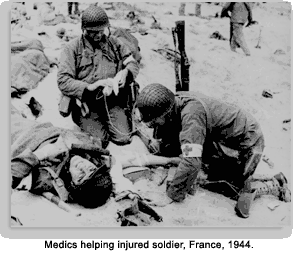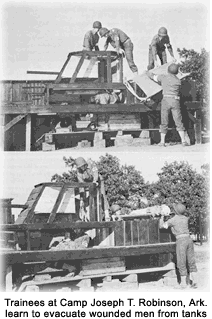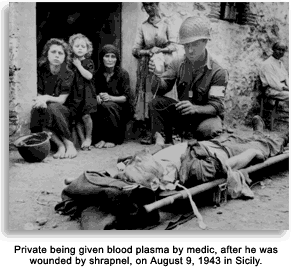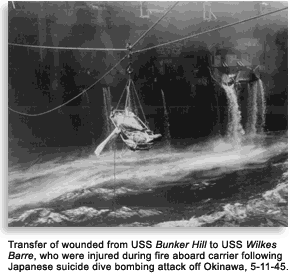In ancient times, if a soldier lay wounded in the field, there was no one to come to his aid.
One of the unsung heroes of World War II was the combat medic. First to answer the call for aid, and often facing the enemy unarmed, he was part of the foundation of the medical system during the war. The combat medic responded on short notice, adapting quickly to current circumstances to administer first aid to a wounded soldier — sometimes under direct fire.
 The Army Medical Service Corps traces its beginning to the American Revolution with the creation of the Ambulance Corps. During the Civil War the Union Army realized there was a need for an integrated medical treatment and evacuation system. With major developments in World War I, the Medical Service Corp initiated the Sanitary Corps to serve in medical logistics.
The onset of World War II inflicted devastating casualties — with a lack of medical professionals at home. Handicapped by lack of funds to construct housing, classrooms and training centers, the Army Medical Department indirectly aggravated the high loss of life at the bombing of Pearl Harbor. To compensate for the lack of readiness, the Army National Guard, Organized Reserves, and affiliated medical units from civilian universities, moved quickly to provide necessary training to technical personnel, nurses and doctors.
With medical training now one of the highest priorities, medics were trained with infantry soldiers, learning how to best use the lay of the land for their protection and that of the wounded soldier. The titles of First-Aid Man, Hospital Orderly, Litter Bearer or Ambulance Driver became part of the Classification of Military Occupational Specialty, or MOS 657. Based on ability, education, training, intelligence, aptitude, occupational history, military experience and other demonstrated qualifications, the MOS number was awarded to the medical student. That information was carefully recorded so that each individual’s skills would be evaluated and assigned accordingly to the duties of most value to the armed forces.
The Army Medical Service Corps traces its beginning to the American Revolution with the creation of the Ambulance Corps. During the Civil War the Union Army realized there was a need for an integrated medical treatment and evacuation system. With major developments in World War I, the Medical Service Corp initiated the Sanitary Corps to serve in medical logistics.
The onset of World War II inflicted devastating casualties — with a lack of medical professionals at home. Handicapped by lack of funds to construct housing, classrooms and training centers, the Army Medical Department indirectly aggravated the high loss of life at the bombing of Pearl Harbor. To compensate for the lack of readiness, the Army National Guard, Organized Reserves, and affiliated medical units from civilian universities, moved quickly to provide necessary training to technical personnel, nurses and doctors.
With medical training now one of the highest priorities, medics were trained with infantry soldiers, learning how to best use the lay of the land for their protection and that of the wounded soldier. The titles of First-Aid Man, Hospital Orderly, Litter Bearer or Ambulance Driver became part of the Classification of Military Occupational Specialty, or MOS 657. Based on ability, education, training, intelligence, aptitude, occupational history, military experience and other demonstrated qualifications, the MOS number was awarded to the medical student. That information was carefully recorded so that each individual’s skills would be evaluated and assigned accordingly to the duties of most value to the armed forces.
 Highly respected and easily identified was the Red Cross symbol on the medic's helmet or arm band, which inadvertently became a conspicuous target for enemy snipers. In general, medics performed numerous duties to assist technicians in the various medical departments. They were responsible for evaluation and treatment of wounds and minor injuries. They were trained to make and apply arm or leg splints, bandage wounds, treat patients for shock, and stop bleeding by applying tourniquets. They performed routine duties that included taking temperature and pulse reading, bathing and feeding patients, preparing patients for surgical procedures as well as cleaning and sterilizing specified areas. They additionally lifted patients onto litters and carried them to aid stations, ambulance loading points, or collecting stations.
The combat medic's main objective was to get to the wounded as quickly as possible and move him away from the front lines. Climbing out of the relative protection of the fox hole, the medic sometimes came under fire as he crawled into no-man’s land to help a fallen comrade. Once there, the medic would conduct a brief evaluation of the wound, apply a tourniquet if necessary, sometimes administer morphine for pain, and clean the wound as best he could for the time being. He would then drag the patient out of harm's way to safety.
During the war, such drugs as sulfa (sulfanilamide) and penicillin were discovered as well as advanced surgical techniques, effectively contributing to the survival rate. A wounded soldier, if treated within the first hour, had an 85 percent chance of survival. Contributing to that survival rate was the speed with which the combat medic on the frontline attended to his patient. At the war's beginning the medics were often ridiculed, sometimes being called "pill pushers," or worse. In combat, however, that attitude drastically changed as they gained respect from all ranks. When a soldier cried out "Medic!" there was no hesitation, and they were eventually referred to as "Doc."
Highly respected and easily identified was the Red Cross symbol on the medic's helmet or arm band, which inadvertently became a conspicuous target for enemy snipers. In general, medics performed numerous duties to assist technicians in the various medical departments. They were responsible for evaluation and treatment of wounds and minor injuries. They were trained to make and apply arm or leg splints, bandage wounds, treat patients for shock, and stop bleeding by applying tourniquets. They performed routine duties that included taking temperature and pulse reading, bathing and feeding patients, preparing patients for surgical procedures as well as cleaning and sterilizing specified areas. They additionally lifted patients onto litters and carried them to aid stations, ambulance loading points, or collecting stations.
The combat medic's main objective was to get to the wounded as quickly as possible and move him away from the front lines. Climbing out of the relative protection of the fox hole, the medic sometimes came under fire as he crawled into no-man’s land to help a fallen comrade. Once there, the medic would conduct a brief evaluation of the wound, apply a tourniquet if necessary, sometimes administer morphine for pain, and clean the wound as best he could for the time being. He would then drag the patient out of harm's way to safety.
During the war, such drugs as sulfa (sulfanilamide) and penicillin were discovered as well as advanced surgical techniques, effectively contributing to the survival rate. A wounded soldier, if treated within the first hour, had an 85 percent chance of survival. Contributing to that survival rate was the speed with which the combat medic on the frontline attended to his patient. At the war's beginning the medics were often ridiculed, sometimes being called "pill pushers," or worse. In combat, however, that attitude drastically changed as they gained respect from all ranks. When a soldier cried out "Medic!" there was no hesitation, and they were eventually referred to as "Doc."
 Medics did whatever was necessary to stabilize the wounded soldier, lessen his pain and get him to a forward aid station. The station lay within a distance of 300 to 1,000 yards of the front line where there was a sergeant and four litter-bearers. Once the wounded soldier was attended to, the "litter team" arrived to carry him to the main aid station or field hospital, today known as the M.A.S.H. unit, one to three miles behind the line. The physician on duty attended to the soldier's wounds and, if necessary, ordered transportation to the nearest general hospital for further treatment.
Air medics were a product of aviation medicine as it evolved throughout World War II. Air evacuation flights were usually equipped with 18 individual litters and could arrive at their destination in less than an hour. Air medics aboard would be responsible for maintaining the wounded soldiers until they arrived at the hospital. More than 1,000,000 wounded GIs were successfully moved by air during World War II.
Medics did whatever was necessary to stabilize the wounded soldier, lessen his pain and get him to a forward aid station. The station lay within a distance of 300 to 1,000 yards of the front line where there was a sergeant and four litter-bearers. Once the wounded soldier was attended to, the "litter team" arrived to carry him to the main aid station or field hospital, today known as the M.A.S.H. unit, one to three miles behind the line. The physician on duty attended to the soldier's wounds and, if necessary, ordered transportation to the nearest general hospital for further treatment.
Air medics were a product of aviation medicine as it evolved throughout World War II. Air evacuation flights were usually equipped with 18 individual litters and could arrive at their destination in less than an hour. Air medics aboard would be responsible for maintaining the wounded soldiers until they arrived at the hospital. More than 1,000,000 wounded GIs were successfully moved by air during World War II.
Whether in a hospital corpsmen's training school, in the warships's sick bay or aboard a hospital ship, the Navy medic attended the job of treating the sick or injured. From the deck watch to the sea rescue, the Navy medic, like his counterparts in the army, gained a reputation of compassion and dedication for his service during the war.
It is estimated that 830,000 medic cards were distributed to personnel throughout World War II. The physicians, dentists, nurses, and enlisted personnel known as the medics cared for some 14 million patients during World War II.
 The Combat Medical Badge (CMB) was introduced on March 3, 1945, for medical personnel who served with detachments during World War II. The badge was designed to provide recognition to the field medic who accompanied the infantryman into battle. According to the Department of the Army, the medic must have been personally present and under fire, to be eligible for the CMB.
Medics served diligently on the battlefield, at sea, and in the air, demonstrated their compassion on a daily basis for millions of servicemen. The reason for countless medical successes was the speed and skill with which the medics initially treated the wounded.
The Combat Medical Badge (CMB) was introduced on March 3, 1945, for medical personnel who served with detachments during World War II. The badge was designed to provide recognition to the field medic who accompanied the infantryman into battle. According to the Department of the Army, the medic must have been personally present and under fire, to be eligible for the CMB.
Medics served diligently on the battlefield, at sea, and in the air, demonstrated their compassion on a daily basis for millions of servicemen. The reason for countless medical successes was the speed and skill with which the medics initially treated the wounded.